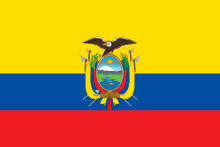
Our intention is to make a brief introduction for each of the different types of Spanish in our articles.
The focus of this particular article is Ecuador.
Spanish is the official language and the language for intercultural cohesion between all the people of Ecuador.
If you could draw an imaginary mapof the Spanish variations according to geography, we could divide it into: Coast, Sierra and East. The Spanish spoken in these three regions is different, and to these geographical differences we add other differences between urban and rural areas.
Guayaquil has also made great efforts to publicize the Guayaquil dialect that, although the words are not exclusive or native to Guayaquil, abound with colloquialisms, dialecticalisms and Anglicisms.
There are many popular expressions used by Ecuadorians. They could amount to nearly ten thousand terms, such as: chuchaqui: state of depression caused by the abuse of alcohol. Fritada: fried pork. Hora ecuatoriana: that which doesn’t respect punctuality but rather delay. Llapingacho: potato omelet made with cheese.
It is also interesting to know how to translate these expressions. In previous articles we mentioned the dilemma sometimes facing the translator in terms of translating a source text literally or in a manner that conveys the intended meaning. The translator must not only know the words, but also interpret what they mean in a given context and to express that in the translation.
Some of these terms are so unique to Ecuadorians that, for example, in New York the word ñañito relates directly to the Ecuadorian people who live there. It is a word influenced by native languages, such as Quechua, and it means “brother”.So, if a Dominican or another person calls you ñañito it is because they think you are from Ecuador.
This would also be difficult to translate because, according to the context, someone could call you ñañito with the intention to say “friend” or with the literal translation as “brother”.
Another language spoken throughout the country is Kichwa, the language spoken by the fourteen Kichwa national groups in the Amazon, on the coast and throughout the Andean region. The speakers of this language are found in the provinces of the inter-Andean corridor and most of the east.Migration processes have made the coastal provinces maintain the use of Kichwa. Outside of Ecuador there are speakers in Peru, Bolivia, Argentina, Colombia, Brazil, Chile and a small number in Paraguay.
The weight of indigenous languages in Ecuador is very relevant andthis importancehas led to the introduction of a bilingual, intercultural education system, which was achieved thanks to the passionate struggle by the nationalities and peoples for their languages and cultures.
Here we summarize some of the indigenous languages:
Ecuadorian Amazon ancestral languages:
• Paikoka: Language spoken by the Sekoya people.
• Shiwiar Chicham: Language spoken by the Shiwiar people.
• Achuar Chicham: Language spoken by the Achuar people.
• A’ingae: Language spoken by the Ai people, commonly known as Cofán.
• Waotededo: Language spoken by the Wao people.
• Shuar Chicham: Language spoken by the Shuar people, who were derisively referred to as Jivaro because of their warrior character.
• Kayapi or Sapara Atupama: Language spoken by the Sapara people.
• Baikoka: Language spoken by the Siona people.
Languages indigenous to the coast:
1. Awapít: Belongs to the Chibcha linguistic family. It is spoken by the Awá people in Ecuador and Colombia.
2. Zia pedee: Means “voice of the reeds”. It belongs to the Epera people.
3. Cha’palaa: language spoken b y the Chachi people.
4. Tsafiqui: Means “man’s tongue” and is spoken by the Tsa’chila people.
As we have seen, Ecuadorian Spanish is incredibly rich, and it is impossible to reduce the language of this nation to a mere “Spanish”. It is interesting to open the doors of each culture and be surprised by the riches.
For more information about the different types of Spanish, direct your inquiry to “Translation Services“.





